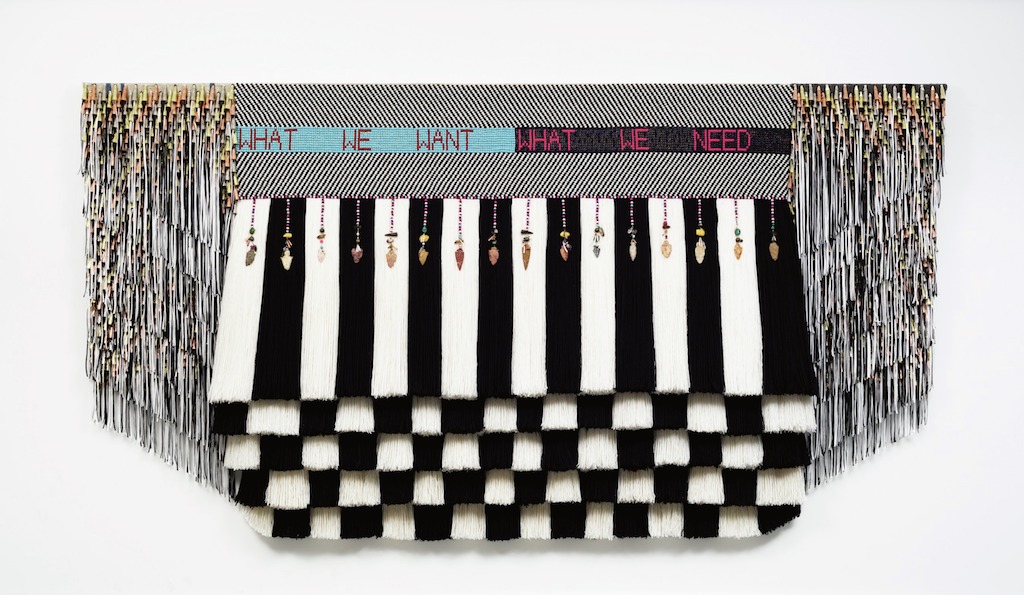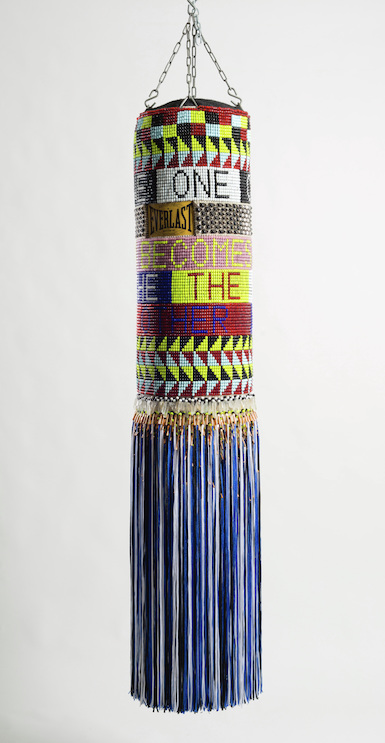[ad_1]

Jeffrey Gibson, WHAT WE WANT, WHAT WE NEED, 2014, repurposed punching bags, glass beads, artificial sinew, acrylic felt, steel and brass.
COURTESY JEFFREY GIBSON STUDIO AND ROBERTS PROJECTS, LOS ANGELES/PETER MAUNEY
Currently on view at the Denver Art Museum is Jeffrey Gibson’s first mid-career survey, “Like a Hammer,” which brings together 57 of the artist’s wall hangings and sculptures, many of which combine elements of punk and his Choctaw and Cherokee heritage. With that show show in mind, republished below is a profile of Jeffrey Gibson that originally ran in ARTnews’s December 2013 issue. Gibson tells Elisabeth Kley that he thinks of his work as a “rejection of hetero-normative culture,” noting the ways that his materials and styles could be considered far from the mainstream. —Alex Greenberger
“Critic’s Pick: Jeffrey Gibson”
By Elisabeth Kley
December 2013
The day he started painting on animal skin rather than canvas, Jeffrey Gibson, an artist of Choctaw and Cherokee descent, made a key breakthrough. “Rawhide is leather in its rawest form. It dries hard and can form to any structure, but there are always reminders of where it comes from—holes in the hide, marks in the skin, hair follicles, and embedded thorns,” Gibson explains. “It’s a visceral material.” His recent solo exhibition at New York’s National Academy Museum featured bright constellations of jagged geometric patterns delineated on deer hide stretched over unusual supports such as ironing boards and swiveling antique mirrors. Parfleches, Native American containers made of animal skin and decorated with abstract shapes by women, are a major inspiration for these painting-sculpture hybrids. And modernist abstraction—which often borrowed tribal imagery—is turned inside out.

Jeffrey Gibson, ONE BECOMES THE OTHER, 2015, repurposed wool army blanket, repurposed punching bag, glass beads, plastic beads, steel studs, artificial sinew, quartz crystals, copper cones, nylon fringe, steel, acrylic paint.
PRIVATE COLLECTION/COURTESY MARC STRAUS GALLERY, NEW YORK/IMAGE COURTESY JEFFREY GIBSON STUDIO AND ROBERTS PROJECTS, LOS ANGELES
The cosmopolitan Gibson grew up in a military family stationed in Germany, South Korea, and the United States. Since earning a B.A. at the School of the Art Institute of Chicago and an M.F.A. from the Royal College of Art, London, he has spent time working in France, New Mexico, and California. Now based in Hudson, New York, Gibson is represented by Marc Straus in New York City and Shoshana Wayne Gallery in Santa Monica, California, where his works sell for up to $38,000. Through next November, he has several pieces spotlighted in the Denver Art Museum’s American Indian art galleries.
Leather also appears in Gibson’s series of light fixtures, arrangements of long cylindrical bulbs wrapped in colored gel and deer hide. “The lights refer to sculpture by Dan Flavin and the painted shapes refer to stylized tribal designs and to paintings by Ellsworth Kelly and 1960s Frank Stella,” Gibson explains. “My recent work has developed over a long period of time looking at and considering work by such dominant artistic figures, and comparing it to objects made by artists who’ve been historically excluded from the mainstream canon.”
Another body of work imbues punching bags with a strangely human presence. Some have long fringes that can flutter in the breeze, along with beads and jingles. “The adornment references subcultural fashion, not just Native American but also punk and queer—alternatives to mainstream that signal defiance and rejection of hetero-normative culture,” Gibson says. Sexual mutability is implied in the female identities these ostensibly male objects take on. She Walks Lightly (2012), for example, could be an immobilized tribal dancer. Both the punching bags and the painted abstractions on flayed skin are suffused with potential violence, slightly twisting the inherent beauty of Gibson’s work.
[ad_2]
Source link

